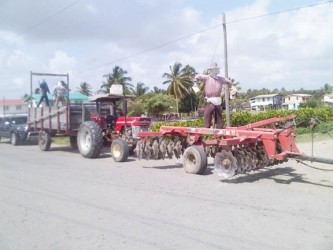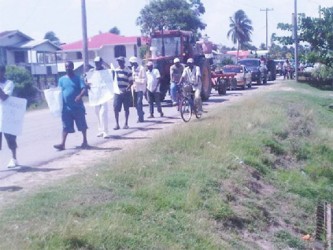Essequibo farmers lined the Reliance to Anna Regina road yesterday with tractors and machinery on which they placed scarecrows to depict the deaths of their livelihoods due to the low paddy prices.
Farmer Sham Narine said the scarecrows represented “those farmers who are hanging themselves or drinking poison because they feel like this situation isn’t going to get better.”
As the protest entered its third day, he stated that farmers brought out their tractors and other machinery because “we aren’t going to work and make little bit of money that we won’t get until months later.” The farmer claimed that the Guyana Rice Development Board (GRDB) and the Rice Producers Association (RPA) were working with the mills to keep paddy prices well below the $4,000 per bag average.

Contacted, GRDB General Manger Jagnarine Singh denied what the farmers said. “All of the reporting is wrong,” Singh said. “I am not against the farmers; the board is not against them.” He said “a small group of the farmers had bad paddy… when Grade ‘A’ was selling for $4,000.”
Singh said this was a reasonable price and farmers were receiving this for the best grade of paddy. However, some farmers were taking paddy that had been damaged by pests and it made no sense for mills to pay a high price for low grade goods.
“Some of the paddy [was] 80 per cent damage[d] so you now need 100 bags to make a tonne of rice when before you would be using something like 25 bags,” Singh told Stabroek News. He said it was not unreasonable for the mills to charge three-quarters less because rice yield would be three-quarters less. Singh said, “I want to emphasise that this is a small group of the farmers.”
He said that on Wednesday he met two sets of farmers and discussed the low price and the reason for it. Singh said a group of 80 farmers met him on Wednesday morning and another group of 40 met him later Wednesday afternoon and “they were reasonable.”
Singh said farmers “are using cheap chemicals that are backtracked products and then when the chemicals aren’t working and the paddy [is] damage[d], the farmers are getting angry. That is not the way to deal with this situation.”
The Pesticide and Toxic Chemicals Control Board (PTCCB), he noted, makes it known which distributors to purchase from and farmers need to take on that responsibility. “Rice farming is a business. They are in it to make money so they have to take on where they are buying their pesticides from,” he said.

Singh stated that in a meeting at the Agriculture Ministry yesterday, the issues raised by farmers were being addressed. The ministry later released a statement citing that slow intake at the rice mills was due to “drying and storage capacity being lower than the existing production”, which is the highest in the history of rice production according to the ministry.
The Ministry of Agriculture has noted that the increased rice production did bring several challenges like the slow intake at the mills. The ministry has dispatched officers from the GRDB, RPA, PTCCB and regional representatives to meet farmers on Sunday.
Stabroek News made multiple attempts to contact mill representatives in the Essequibo region, but was unable to do so up to press time.




